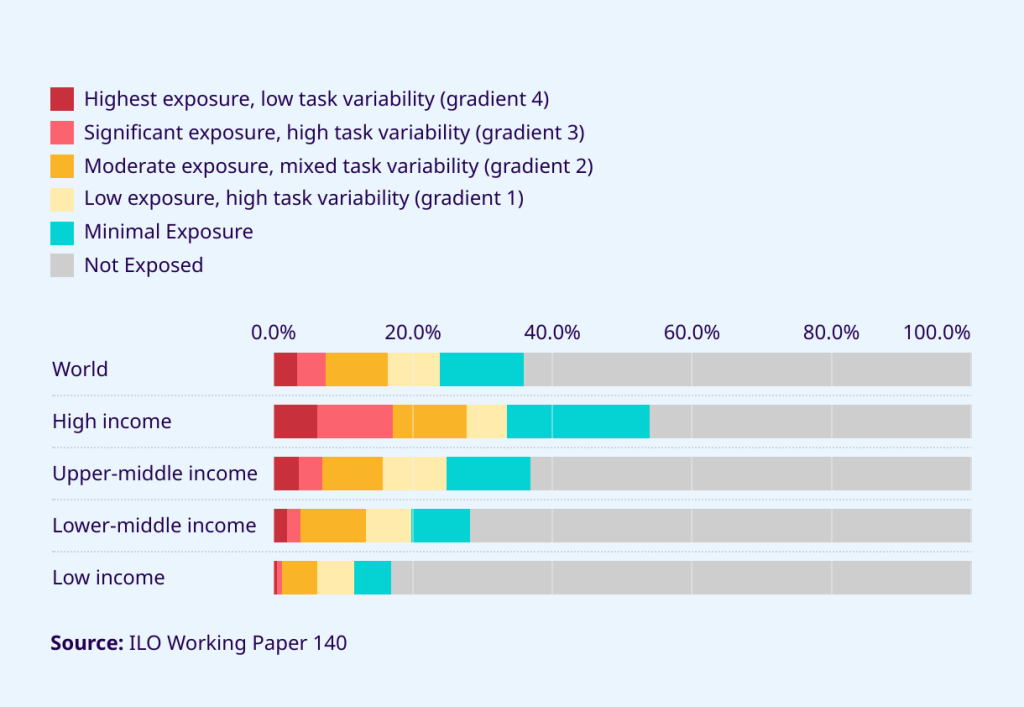By Dr. Gyan Pathak
About one in four jobs (24 per cent) globally is running a risk to be exposed to Generative Artificial Intelligence (GenAI,) but the exposure is likely to be transformative, not replacement, shows the refined global index of exposure to GenAI. The new ILO-NASK global index shows that the exposure in the high-income countries would be 34 per cent, but in the low-income countries it would be only 11 per cent. In absolute number, 838 million jobs globally are exposed to GenAI, out of which more than half 442 million are in Asia and the Pacific.
In per centage term, 19 per cent jobs in Africa, 22 per cent in Asia and the Pacific, 25 per cent in Arab States, 29 per cent in Americas, and 32 per cent in Europe and Central Asia are exposed to GenAI. In upper-middle income countries exposure level is 25 per cent and in lower-middle income countries it is 20 per cent.
“It is important to stress that these new estimates reflect “exposure” to GenAI and not the actual impact on employment,” says the report titled ‘Generative AI and Jobs: A Refined Global Index of Occupation Exposure’. “Infrastructure constraints (electricity, broadband), insufficient digital skills, the cost of technology, and inherent operational difficulties associated with the technology are just some of the barriers to full adoption.”
An important aspect also concerns the institutional and societal acceptance of automating tasks and occupations – even when technically feasible. For instance, few consumers may be inclined to watch evening news presented by avatars. Similarly, financial institutions might hesitate to fully delegate decisions such as mortgage approvals or business plan evaluations to AI systems, preferring to retain human judgement, oversight and accountability, emphasized the report. “Indeed, the results indicate that few jobs consist of tasks that are fully automatable with current GenAI technology; nearly all occupations have some tasks that require human input.” The “bundle of tasks” that constitutes occupations acts as a buffer against full automation.
However, the report warns, this does not mean that demand for these occupations will remain stable, as the efficiencies gained from introducing technology may mean that fewer workers are needed. If efforts are not made to help such jobs evolve with GenAI and integrate new tasks, even partial automation of existing tasks could lead to a decline in overall job demand in occupations found in higher exposure gradients. In addition, in some cases, the remaining set of non-automated tasks may result in jobs that are no longer humanly sustainable or desirable, thereby limiting the feasibility of adopting imbalanced technological solutions.
Nevertheless, the estimates do not account for new jobs that may be created, nor the technological advances that could potentially automate more tasks in the future. In that sense, our estimates, says the report, present a static snapshot of the exposure of existing occupations to GenAI at the start of 2025.
At the global level, about a quarter of all employment falls into one of the four exposure gradients, with significant differences between female and male employment, particularly in the top two exposure gradients. The report talks about 4 gradients, from lowest exposure 1 to highest 4.
Among male workers, approximately one-fifth of jobs fall within one of the exposure gradients, with 3.1% in gradient 3 and 2.4% in the highest exposure gradient (gradient 4). In contrast, not only is the total share of female employment in potentially exposed occupations notably higher, but the difference is also concentrated in the top two gradients, with 5.7% of female employment in gradient 3 and another 4.7% in gradient 4.
These disparities are even more pronounced in High-Income Countries, where 34% of total employment falls within one of the four exposure gradients, with 17.3% in gradients 3 and 4. However, when disaggregated by gender, 28% of male employment is exposed, with only 3.5% in gradient 4, compared to 41% of female employment, with 14.4% in gradient 3 and 9.6% in gradient 4.
Income-based differences in exposure are striking, with High-Income Countries showing the highest share of employment in one of the four exposure gradients (34%). The total share of exposed employment declines significantly as income levels decrease, reaching just 11% in Low-Income Countries (LICs).
Lower income levels also reduce gender disparities in exposure, primarily due to the lower concentration of occupations in the highest exposure gradients (gradients 3and 4). Gender disparities are also more pronounced in wealthier regions, particularly in Europe and Central Asia, where 39% of female employment falls into one of the four exposure gradients compared to 26% for men. These patterns reflect both occupational structures and the extent to which GenAI-exposed roles, such as clerical, financial, and customer service jobs, are concentrated in higher-income countries.
These new estimates are consistent with those given in 2023, but more refined. The previous version attributed 2.3% of global employment to the “automation” category, one percentage point lower than the 3.3% assigned to gradient 4. In addition, the 2023 estimate attributed 13%of employment as subject to “augmentation” and an additional 16.2% of employment in “the big unknown”.
However, the combined employment share for Gradients 1-3 for the world in the current analysis is 20.5%, 9 percentage points lower than combined shares of augmentation and “the big unknown” (29.2%) reported in 2023. The 2023 findings that women are more affected than men, and that the percentage of employment affected increases as countries’ income level increases, still hold. (IPA Service)




 Centre Is Resorting To Cheap Political Drama Through President Referring SC Judgment To Court Itself
Centre Is Resorting To Cheap Political Drama Through President Referring SC Judgment To Court Itself 